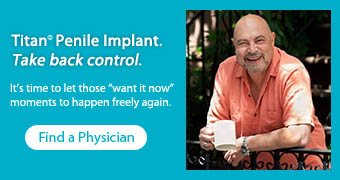Rear Tip Extenders and Penile Prosthesis Rigidity: A Laboratory Study of Coloplast Prostheses.
-
NextStepImplant
- Posts: 70
- Joined: Fri May 17, 2019 6:22 am
Re: Rear Tip Extenders and Penile Prosthesis Rigidity: A Laboratory Study of Coloplast Prostheses.
Yes the girth of the cylinders is bigger on the longer implants. If you look at the maximum rigidity factor column (3rd column) and compare that number to the size of implant (22cm has a max rigidity of .77 and the 24cm has a max rigidity of .79) the bigger the implant the more rigid it is because of its girth. The increasing girth of the cylinders (20.22.24.26.28) allows the longer cylinders to be more resistant to buckling.
Re: Rear Tip Extenders and Penile Prosthesis Rigidity: A Laboratory Study of Coloplast Prostheses.
thereishope wrote:oldbeek wrote:If you have a 5cm deep cruses, do the pressure tubes on a 20cm implant enter the cylinder down in your perineum area? Surely have to be a scrotal installation. Would the pressure tubing be inside the cruses area then run parallel to the inflatable till they exit into your scrotum. Mine was pubic entry and the tubes exit right at my pubic bone. Some body with a deep cruses and no RTE please enlighten me on how their tubing runs. Very curious.
What does this even have to do with anything? As i expected, you totally disregarded my comment you hanging a towel on your penis and showing us factual proofof it .Kind of reminded me of other times in this board when we had a guy claiming that his stretching routine increased his penile size a great deal and when he was called out on it to show proof, he ran away from it for ages, eventually showing us nothing; (because there was nothing to begin with?)
Whilst i don't doubt your implant gets hard, and you can still have pleasure with it, claims like yours pass on the impression that RTE'S don't matter and don't affect the quality of the erection when that is actually not the case. Not only there is proof of it, as i have link here on the initial post, as there on the post that the images were linked, and here ( https://www.smsna.org/scottsdale2016/presentations/206.pdf. Also, i've spoken with guys that had AMS with RTE's and had revisions for Titan's with NO RTE's and they said that there is definitely a difference for the better in terms of stiffness.
This nonsense should be combated at all cost. Everybody should be informed of this, given that it may impact their doctor selection, since we all know, certain doctors care more about this particular item than others.
The study ends like this, as you can see for yourself:Conclusion:
•Greater bending deflection was associated with the use of greater RTE length
•Use of RTE decreases the inflatable portion of the cylinder that is supported by the crus
•This data supports the notion that minimizing RTEs improves cylinder stiffness and overall erectile rigidity dynamics
•Decreasing the length of the non inflatable proximal portion decreases the bending deflection
•These observations could possibly improve the design of the next generation of cylinders
I come back to edit this post, because as i was browsing through pubmed i came across this very informative paper:
https://www.ncbi.nlm.nih.gov/pmc/articles/PMC7108986/It is well established that surgical outcomes tend to improve as surgeon volume increases (13,14). In a simplistic sense, this may relate to an increasing expertise and efficiency on the part of the surgeon, but it is equally likely that improvements in systems (e.g., operating room staff that are knowledgeable about the procedure, established treatment pathways for surgical patients, etc.) also contribute to these superior outcomes (15). Penile implants are no exception to this general rule of surgical outcomes; ergo, it may be preferable that penile prosthesis surgery not be performed by “dabblers” but rather by individuals who have had intensive training and/or extensive experience with implant surgery. A greater depth of experience and knowledge enables the implant surgeon to recognize and manage problems and potential solutions. This “center of excellence” concept is well recognized in the realm of urologic oncology, but there is no reason it cannot be applied to benign urologic surgeries such as penile implant placement.
Crucially, the enhanced ability of an experienced surgeon to recognize and manage potential problems applies in terms of both pre-operative counseling and intraoperative management. Most experienced implant surgeons have cared for patients with unreasonable or unattainable expectations. Trost et al. summarized these sorts of patients in an excellent review paper using the acronym “CURSED Penis”, referring to patients with tendencies to be Compulsive/Obsessive, Unrealistic, requesting Revision, Shopping for numerous surgeons, Entitled, in Denial, or carrying a Psychiatric diagnosis (e.g., mood disorder, body dysmorphic disorder, substance abuse) (16). Standards of medical professionalism dictate that even patients with these disorders not necessarily be denied management of ED with a penile implant; however, when there is abundant evidence that the patient’s perceived outcomes are likely to be poor, the surgeon is best served to defer management until such time as reasonable expectations about post-operative functional status can be set with the patient. Pre-operative expectations are a very strong predictor of post-operative outcome (17); it is essential that the patient approach penile prosthetic surgery with a reasonable idea of what a penile implant can and cannot do.
Go to:
Trends in operative management
Interestingly, the measured length of penile corpora and implant length shows a trend towards slight but significant increase over time. These findings were obtained from manufacturer data so causality cannot be inferred; whether this represents (ranked of in order of decreasing likelihood based on our collective opinion) a trend towards more aggressive sizing on the part of surgeons, a trend towards greater desire for implants among patients with larger phallus size, or a shift in population penis size over a very short interval of time is unclear (18). Regardless of cause, there is obviously an upward limit on the size of implant that can be placed without major risk, so we do not foresee this as a trend that will continue indefinitely.
Increasing mean penile length also begs the question of how to size prostheses appropriately. Although clinical data are not conclusive, experimental data indicate that greater a utilization of rear tip extenders is associated with lower axial rigidity of the activated penile prosthetic, particularly in larger size implants (19,20). This may relate to instability at the interface between the inflatable and non-inflatable device components and/or the relatively smaller size of the inflatable device itself when rear tip extenders are used to constitute the corporal length. The benefits of minimizing rear tip extenders must be balanced against technical challenges accessing the proximal portions of the crura and/or burying implant tubing with the corpora itself. Optimal use of rear tip extenders in the future is likely to be driven largely by surgeon preference and patient factors.
Nice long rant. Just asking how it would be done with a 5 cm deep cruses. For the record my Dr was a professor at USC Keck Medicine in Los Angeles. He had been doing IPs for 30 years at the rate of over 250 a year. 6 other drs at Keck also do IPs. My doc claimed their volume is more than Kramer and Eid combined. I really doubt it was a matter of not having the right size on hand. He does only do infrapubic so the need to use RTE to get the inflations tubing to exit at or in front of the pubic bone. I WAS ASKING " " HOW IS THE INFLATE TUBING ROUTED IF YOUR CRUSES BASE IS CLEAR BACK NEXT TO MY ASS HOLE" " NO need for a rant. NOT trying to argue your point. JUST. asking how is the tubing routed on a deep cruses. I don't do pictures! I am happy with what I have except for all the nerve damage done by the prostatectomy surgeon at another major LA cancer center.
82, good health, RP 7-2017, all nerves taken , PSA 0.05, 4-18,, .07 1/19,.05 4/19, .03 11-21, .04 11-23, implanted 4-1-18, Infra-pubic, AMS lgx 15 cm with 5cm rte. Implant at USC Keck. Dr Boyd and Dr Loh Doyle 6.5 x 5, 800 AUS 7-21-20
-
NextStepImplant
- Posts: 70
- Joined: Fri May 17, 2019 6:22 am
Re: Rear Tip Extenders and Penile Prosthesis Rigidity: A Laboratory Study of Coloplast Prostheses.
If your happy then who gives a shit right?
Re: Rear Tip Extenders and Penile Prosthesis Rigidity: A Laboratory Study of Coloplast Prostheses.
THERISHOPE!! Read paragraph in red. Next to last sentence. " The benefits of minimizing RTEs, MUST BE BALANCED, against technical challenges of accessing the proximal portion of the cure and/or burying the tubing within the corpa it's self.
Quit trying to make a point that RTEs are bad in all cases, AND, if you have RTEs you got a shitty job.
Not all of use have an inflatable portion that is 19-20 cm long as the study notes that may bend if weight is exerted at the glans.
Quit trying to make a point that RTEs are bad in all cases, AND, if you have RTEs you got a shitty job.
Not all of use have an inflatable portion that is 19-20 cm long as the study notes that may bend if weight is exerted at the glans.
82, good health, RP 7-2017, all nerves taken , PSA 0.05, 4-18,, .07 1/19,.05 4/19, .03 11-21, .04 11-23, implanted 4-1-18, Infra-pubic, AMS lgx 15 cm with 5cm rte. Implant at USC Keck. Dr Boyd and Dr Loh Doyle 6.5 x 5, 800 AUS 7-21-20
-
thereishope
- Posts: 190
- Joined: Sat Oct 27, 2018 3:22 am
Re: Rear Tip Extenders and Penile Prosthesis Rigidity: A Laboratory Study of Coloplast Prostheses.
oldbeek wrote:THERISHOPE!! Read paragraph in red. Next to last sentence. " The benefits of minimizing RTEs, MUST BE BALANCED, against technical challenges of accessing the proximal portion of the cure and/or burying the tubing within the corpa it's self.
Quit trying to make a point that RTEs are bad in all cases, AND, if you have RTEs you got a shitty job.
Not all of use have an inflatable portion that is 19-20 cm long as the study notes that may bend if weight is exerted at the glans.
Sure.. they do have a place, for obvious reasons like you said. Even in the pdf from Dr. Eid, they ask the question: "what is the average size of the crus?". But how do you explain to me that Dr. Kramer and Dr Eid, significantly use less RTE's than other doctors? and that is just judging but the cases we have on this board of patients that went to them, and reported over here.
Re: Rear Tip Extenders and Penile Prosthesis Rigidity: A Laboratory Study of Coloplast Prostheses.
I can't help smiling over here on the other sidse of the planet in my Wuhan virus lockdown.
This topic will always bring out some guys with n=1 completely non-logic base of "I have a stack of RTEs and my dick is great". Nobody is saying that nobody should ever have any RTEs.
What many are saying, including myself, is that ON AVERAGE - read that again - ON AVERAGE - rigidity and angle (especially after a few years) are better the less RTEs are used.
ON AVERAGE does not mean that out of 1000 non-RTE impland dicks, all 1000 have better rigidity than the best dick out of 1000 RTE dicks.
It just means that if we measure the average rigidity of the 1000 non-RTE dicks, it will be higher than the average of the 1000 non-RTE dicks.
That's it. Oldbeek, if you understand and agree with that, then I don't understand what/who you argue.
Nobody says that you should not have got your 5 cm of RTEs. We don't know your anatomy etc. All I say is that if you had no RTEs, most likely your rigidity would have been (even) better than today.
But if there were other reasons, then you got a good trade-off. Leaving some rigidity on the table and getting better tubing routing or whatever you got.
I think the post above makes a good point worth thinking about. Why do some of the experienced top surgeons use less RTEs on average than the average hacker?
Because for some weid coincidence their patients all have optimal crus depths? Of course not. Because they are more skillful and can insert the implant deep in the crus without RTEs, and because they can route the tubing better even with less use of RTEs.
And btw, being a professor does not necessarily make you a better surgeon. It rather means you have spent less time with the knife and more time behind your computer, at the unversity teaching, at conferences, licking someone's ass and reading journals.
Two reasons less experienced/skilfull surgeons use more RTEs on average are:
1-It is easier to bury the implant deep in the crus with more RTEs. Quite easily understood. Try inserting a balloon nicely stretched out in a thin hole vs inserting a long fixed stick.
2-Their measurement is a bit off. Then once they instal the implant size they chose, it does not fit. If they had chosen a too large implant, they they are in trouble. Either use it and risk erosion. Or remove it, throw it in the bin, and take a new smaller implant and install it. If what they chose was too small, their options are to either remove it, throw it in the bin, and take a new larger implant. Or they just add RTEs.
So the safe way for them, is to measure, use a bit smaller implant than what they measured, add an RTE. Then when installing, if they need larger, they just add even more RTEs. If they need smaller, they just remove RTEs. In this way, they never risk having to trash an implant.
Anyway, my bottom line, what is that?
My conviction (and Eid's and Kramer's) is that the less RTEs you can have, the better. All else being equal. But once at the operating table, you cannot do anything. If you wake up with 5 cm RTEs, they are there to stay. Your surgeon will have an excuse, valid or not, but your RTEs are already there.
So as always - pick a good surgeon. Or rather, pick the best surgeon.
This topic will always bring out some guys with n=1 completely non-logic base of "I have a stack of RTEs and my dick is great". Nobody is saying that nobody should ever have any RTEs.
What many are saying, including myself, is that ON AVERAGE - read that again - ON AVERAGE - rigidity and angle (especially after a few years) are better the less RTEs are used.
ON AVERAGE does not mean that out of 1000 non-RTE impland dicks, all 1000 have better rigidity than the best dick out of 1000 RTE dicks.
It just means that if we measure the average rigidity of the 1000 non-RTE dicks, it will be higher than the average of the 1000 non-RTE dicks.
That's it. Oldbeek, if you understand and agree with that, then I don't understand what/who you argue.
Nobody says that you should not have got your 5 cm of RTEs. We don't know your anatomy etc. All I say is that if you had no RTEs, most likely your rigidity would have been (even) better than today.
But if there were other reasons, then you got a good trade-off. Leaving some rigidity on the table and getting better tubing routing or whatever you got.
I think the post above makes a good point worth thinking about. Why do some of the experienced top surgeons use less RTEs on average than the average hacker?
Because for some weid coincidence their patients all have optimal crus depths? Of course not. Because they are more skillful and can insert the implant deep in the crus without RTEs, and because they can route the tubing better even with less use of RTEs.
And btw, being a professor does not necessarily make you a better surgeon. It rather means you have spent less time with the knife and more time behind your computer, at the unversity teaching, at conferences, licking someone's ass and reading journals.
Two reasons less experienced/skilfull surgeons use more RTEs on average are:
1-It is easier to bury the implant deep in the crus with more RTEs. Quite easily understood. Try inserting a balloon nicely stretched out in a thin hole vs inserting a long fixed stick.
2-Their measurement is a bit off. Then once they instal the implant size they chose, it does not fit. If they had chosen a too large implant, they they are in trouble. Either use it and risk erosion. Or remove it, throw it in the bin, and take a new smaller implant and install it. If what they chose was too small, their options are to either remove it, throw it in the bin, and take a new larger implant. Or they just add RTEs.
So the safe way for them, is to measure, use a bit smaller implant than what they measured, add an RTE. Then when installing, if they need larger, they just add even more RTEs. If they need smaller, they just remove RTEs. In this way, they never risk having to trash an implant.
Anyway, my bottom line, what is that?
My conviction (and Eid's and Kramer's) is that the less RTEs you can have, the better. All else being equal. But once at the operating table, you cannot do anything. If you wake up with 5 cm RTEs, they are there to stay. Your surgeon will have an excuse, valid or not, but your RTEs are already there.
So as always - pick a good surgeon. Or rather, pick the best surgeon.
43 yo, ED forever from VL
Fit and active
Implanted December 2015
Titan XL 24 cm, no RTEs
Dr. Eid
Activated day 13
Sex after 3 weeks
Gained length and girth
So far It works perfectly
Only one advice: Find a world class surgeon
Fit and active
Implanted December 2015
Titan XL 24 cm, no RTEs
Dr. Eid
Activated day 13
Sex after 3 weeks
Gained length and girth
So far It works perfectly
Only one advice: Find a world class surgeon
Re: Rear Tip Extenders and Penile Prosthesis Rigidity: A Laboratory Study of Coloplast Prostheses.
Ymerrix wrote:I can't help smiling over here on the other sidse of the planet in my Wuhan virus lockdown.
This topic will always bring out some guys with n=1 completely non-logic base of "I have a stack of RTEs and my dick is great". Nobody is saying that nobody should ever have any RTEs.
What many are saying, including myself, is that ON AVERAGE - read that again - ON AVERAGE - rigidity and angle (especially after a few years) are better the less RTEs are used.
ON AVERAGE does not mean that out of 1000 non-RTE impland dicks, all 1000 have better rigidity than the best dick out of 1000 RTE dicks.
It just means that if we measure the average rigidity of the 1000 non-RTE dicks, it will be higher than the average of the 1000 non-RTE dicks.
That's it. Oldbeek, if you understand and agree with that, then I don't understand what/who you argue.
Nobody says that you should not have got your 5 cm of RTEs. We don't know your anatomy etc. All I say is that if you had no RTEs, most likely your rigidity would have been (even) better than today.
But if there were other reasons, then you got a good trade-off. Leaving some rigidity on the table and getting better tubing routing or whatever you got.
I think the post above makes a good point worth thinking about. Why do some of the experienced top surgeons use less RTEs on average than the average hacker?
Because for some weid coincidence their patients all have optimal crus depths? Of course not. Because they are more skillful and can insert the implant deep in the crus without RTEs, and because they can route the tubing better even with less use of RTEs.
And btw, being a professor does not necessarily make you a better surgeon. It rather means you have spent less time with the knife and more time behind your computer, at the unversity teaching, at conferences, licking someone's ass and reading journals.
Two reasons less experienced/skilfull surgeons use more RTEs on average are:
1-It is easier to bury the implant deep in the crus with more RTEs. Quite easily understood. Try inserting a balloon nicely stretched out in a thin hole vs inserting a long fixed stick.
2-Their measurement is a bit off. Then once they instal the implant size they chose, it does not fit. If they had chosen a too large implant, they they are in trouble. Either use it and risk erosion. Or remove it, throw it in the bin, and take a new smaller implant and install it. If what they chose was too small, their options are to either remove it, throw it in the bin, and take a new larger implant. Or they just add RTEs.
So the safe way for them, is to measure, use a bit smaller implant than what they measured, add an RTE. Then when installing, if they need larger, they just add even more RTEs. If they need smaller, they just remove RTEs. In this way, they never risk having to trash an implant.
Anyway, my bottom line, what is that?
My conviction (and Eid's and Kramer's) is that the less RTEs you can have, the better. All else being equal. But once at the operating table, you cannot do anything. If you wake up with 5 cm RTEs, they are there to stay. Your surgeon will have an excuse, valid or not, but your RTEs are already there.
So as always - pick a good surgeon. Or rather, pick the best surgeon.
You have a nice long implant. So where do your tubes enter the inflatable? In your perineum or in your scrotum. When you inflate your implant can you feel it getting larger deep in your Cruse?
82, good health, RP 7-2017, all nerves taken , PSA 0.05, 4-18,, .07 1/19,.05 4/19, .03 11-21, .04 11-23, implanted 4-1-18, Infra-pubic, AMS lgx 15 cm with 5cm rte. Implant at USC Keck. Dr Boyd and Dr Loh Doyle 6.5 x 5, 800 AUS 7-21-20
Re: Rear Tip Extenders and Penile Prosthesis Rigidity: A Laboratory Study of Coloplast Prostheses.
. AS for a professor not being skilled. Where did Eid and Kramer learn their skill? In a kindergarten sand box? NO... At a teaching hospital under the guidance of a professor. The class room for these guys is in the operating room. You learn in the operating room experiencing many different circumstances.oldbeek wrote:Ymerrix wrote:I can't help smiling over here on the other sidse of the planet in my Wuhan virus lockdown.
This topic will always bring out some guys with n=1 completely non-logic base of "I have a stack of RTEs and my dick is great". Nobody is saying that nobody should ever have any RTEs.
What many are saying, including myself, is that ON AVERAGE - read that again - ON AVERAGE - rigidity and angle (especially after a few years) are better the less RTEs are used.
ON AVERAGE does not mean that out of 1000 non-RTE impland dicks, all 1000 have better rigidity than the best dick out of 1000 RTE dicks.
It just means that if we measure the average rigidity of the 1000 non-RTE dicks, it will be higher than the average of the 1000 non-RTE dicks.
That's it. Oldbeek, if you understand and agree with that, then I don't understand what/who you argue.
Nobody says that you should not have got your 5 cm of RTEs. We don't know your anatomy etc. All I say is that if you had no RTEs, most likely your rigidity would have been (even) better than today.
But if there were other reasons, then you got a good trade-off. Leaving some rigidity on the table and getting better tubing routing or whatever you got.
I think the post above makes a good point worth thinking about. Why do some of the experienced top surgeons use less RTEs on average than the average hacker?
Because for some weid coincidence their patients all have optimal crus depths? Of course not. Because they are more skillful and can insert the implant deep in the crus without RTEs, and because they can route the tubing better even with less use of RTEs.
And btw, being a professor does not necessarily make you a better surgeon. It rather means you have spent less time with the knife and more time behind your computer, at the unversity teaching, at conferences, licking someone's ass and reading journals.
Two reasons less experienced/skilfull surgeons use more RTEs on average are:
1-It is easier to bury the implant deep in the crus with more RTEs. Quite easily understood. Try inserting a balloon nicely stretched out in a thin hole vs inserting a long fixed stick.
2-Their measurement is a bit off. Then once they instal the implant size they chose, it does not fit. If they had chosen a too large implant, they they are in trouble. Either use it and risk erosion. Or remove it, throw it in the bin, and take a new smaller implant and install it. If what they chose was too small, their options are to either remove it, throw it in the bin, and take a new larger implant. Or they just add RTEs.
So the safe way for them, is to measure, use a bit smaller implant than what they measured, add an RTE. Then when installing, if they need larger, they just add even more RTEs. If they need smaller, they just remove RTEs. In this way, they never risk having to trash an implant.
Anyway, my bottom line, what is that?
My conviction (and Eid's and Kramer's) is that the less RTEs you can have, the better. All else being equal. But once at the operating table, you cannot do anything. If you wake up with 5 cm RTEs, they are there to stay. Your surgeon will have an excuse, valid or not, but your RTEs are already there.
So as always - pick a good surgeon. Or rather, pick the best surgeon.
You have a nice long implant. So where do your tubes enter the inflatable? In your perineum or in your scrotum. When you inflate your implant can you feel it getting larger deep in your Cruse?
82, good health, RP 7-2017, all nerves taken , PSA 0.05, 4-18,, .07 1/19,.05 4/19, .03 11-21, .04 11-23, implanted 4-1-18, Infra-pubic, AMS lgx 15 cm with 5cm rte. Implant at USC Keck. Dr Boyd and Dr Loh Doyle 6.5 x 5, 800 AUS 7-21-20
Re: Rear Tip Extenders and Penile Prosthesis Rigidity: A Laboratory Study of Coloplast Prostheses.
Yes I can feel it inflate in my crus. Where tubing enters? Not in my crus, that would hurt I guess. Couldn't even sit down then. Not really in my scrotum either. Hard to explain. Underneath my dick, a bit inside me. Must "bury" my finger along my shaft inside my body to feel it.
I didn't say professors were not skilled. I guess some are and some are not. I just say that because you are a professor you don't necessarily do the surgery better. You don't become a professor for your practical skills. But because of your academic success. For publishing papers. For your theoretical knowledge (and perhaps partly due to your political skills in the academic world).
Would you rather have a teaching professor who does 5 implants per year do your dick or a surgeon who does 1000 per year?
I know what I'd prefer.
Of course, if there was a professor who was high volume surgeon as well - great. But I think that combo is sort of hard to find. If you put your focus in the academics then you won't have time to do 3 surgeries per day...
I didn't say professors were not skilled. I guess some are and some are not. I just say that because you are a professor you don't necessarily do the surgery better. You don't become a professor for your practical skills. But because of your academic success. For publishing papers. For your theoretical knowledge (and perhaps partly due to your political skills in the academic world).
Would you rather have a teaching professor who does 5 implants per year do your dick or a surgeon who does 1000 per year?
I know what I'd prefer.
Of course, if there was a professor who was high volume surgeon as well - great. But I think that combo is sort of hard to find. If you put your focus in the academics then you won't have time to do 3 surgeries per day...
43 yo, ED forever from VL
Fit and active
Implanted December 2015
Titan XL 24 cm, no RTEs
Dr. Eid
Activated day 13
Sex after 3 weeks
Gained length and girth
So far It works perfectly
Only one advice: Find a world class surgeon
Fit and active
Implanted December 2015
Titan XL 24 cm, no RTEs
Dr. Eid
Activated day 13
Sex after 3 weeks
Gained length and girth
So far It works perfectly
Only one advice: Find a world class surgeon
Re: Rear Tip Extenders and Penile Prosthesis Rigidity: A Laboratory Study of Coloplast Prostheses.
merrix wrote:Yes I can feel it inflate in my crus. Where tubing enters? Not in my crus, that would hurt I guess. Couldn't even sit down then. Not really in my scrotum either. Hard to explain. Underneath my dick, a bit inside me. Must "bury" my finger along my shaft inside my body to feel it.
I didn't say professors were not skilled. I guess some are and some are not. I just say that because you are a professor you don't necessarily do the surgery better. You don't become a professor for your practical skills. But because of your academic success. For publishing papers. For your theoretical knowledge (and perhaps partly due to your political skills in the academic world).
Would you rather have a teaching professor who does 5 implants per year do your dick or a surgeon who does 1000 per year?
I know what I'd prefer.
Of course, if there was a professor who was high volume surgeon as well - great. But I think that combo is sort of hard to find. If you put your focus in the academics then you won't have time to do 3 surgeries per day...
Thanks for the answer. Because of the way the tubes have to enter when access is gained infrapubic,(tubes in front of pubic bone) RTEs have to be used with a deep cruse. So if a new guy is watching this subject, I would recommend only use a surgeon that does scrotal entry to eliminate the use of RTEs. I have now what I have and with cancer chasing me daily, I doubt I will ever need a revision.
82, good health, RP 7-2017, all nerves taken , PSA 0.05, 4-18,, .07 1/19,.05 4/19, .03 11-21, .04 11-23, implanted 4-1-18, Infra-pubic, AMS lgx 15 cm with 5cm rte. Implant at USC Keck. Dr Boyd and Dr Loh Doyle 6.5 x 5, 800 AUS 7-21-20
Who is online
Users browsing this forum: bp1111 and 66 guests






